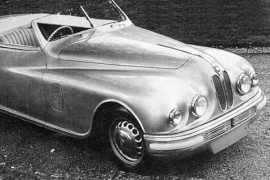BRISTOL 402 Models/Series Timeline, Specifications & Photos
First production year: 1949
Engines: Gasoline
Body style: Convertible (spider/spyder, cabrio/cabriolet, drop/open/soft top)
The British carmaker already had a license from BMW for the two-liter inline-six engine and the four-speed gearbox and used that to create and raise the Bristol brand.
In 1948, the carmaker rushed on the market with an open-top version for the Bristol 401 and named-it drop-head. While the vehicle still relied on the underpinnings from the Bristol 400, which was mostly a licensed BMW 327, it revealed a new bodywork. Unfortunately, the car was way too bold for its time.
Bristol used the same BMW kidney-grille at the front but added two more parking lights on the outer side of the front fenders, next to the main headlamps. Its arched and profiled fenders resembled those from the model 401. Its open-top bodywork was long enough to allow the canopy to retract behind the seats completely. In the long, boat-tail style, rear-end, the carmaker installed the trunk with the spare wheel inside. At the BMW 327, that was on the trunk lid.
Inside, the carmaker made a leather-clad interior. The dashboard sported squared dials for the speedometer, tachometer, and fuel level. Its curved two-spokes from the steering wheel resembled an aircraft helm.
Under the hood, the carmaker used the three-carburetor version of the BMW's 2.0-liter inline-six engine, which produced 86 hp. Bristol used the same front-independent suspension with a transverse leaf spring and a live axle in the rear. But the car didn't prove to be successful and sold only 26 units. Other sources stated that only 23 ever left the assembly lines.
